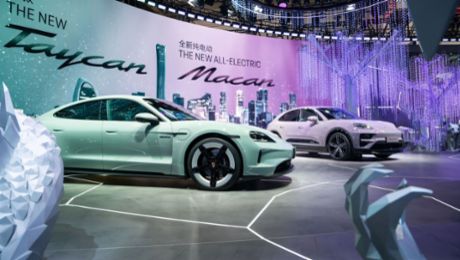Since 2014, Porsche has delivered more than 850,000 examples of the Macan worldwide. Ten years after its launch, the second model generation is here, and in all-electric form. Through its progressive, timeless design and with characteristic Porsche performance, long-distance range and great everyday usability, the new Macan 4 (Macan 4 Electric: Electric power consumption* combined (WLTP) 21.1 – 17.9 kWh/100 km, CO₂ emissions* combined (WLTP) 0 g/km, CO2 class A ) and Macan Turbo (Macan Turbo Electric: Electric power consumption* combined (WLTP) 20.7 – 18.8 kWh/100 km, CO₂ emissions* combined (WLTP) 0 g/km, CO2 class A ) aim to completely fulfil the requirements of Porsche customers who wish to drive an SUV. The cars will be built at the Porsche plant in Leipzig on a CO₂-neutral basis, with the first customers taking delivery during the second half of this year. In combination with Launch Control, the Macan 4 produces up to 300 kW (408 PS) of overboost power, while the Macan Turbo boasts up to 470 kW (639 PS). The maximum torque is 650 and 1,130 Nm, respectively.
This guarantees excellent driving performance. The Macan 4 accelerates from 0 to 100 km/h in just 5.2 seconds, while the Macan Turbo takes just 3.3 seconds. They reach top speeds of 220 and 260 km/h, respectively. The combined WLTP range is up to 591 kilometres in the Macan Turbo and up to 613 kilometres in the Macan 4. With both models, WLTP ranges (EAER City) of well over 700 kilometres are also possible in pure city driving. Another feature with high everyday relevance: the SUV can tow trailers weighing up to two tonnes with the optional towing device.
“We are taking the Macan to a completely new level – with exceptional E-Performance, the new driver experience, and a very impressive design,” says Oliver Blume, Chairman of the Executive Board of Porsche AG. “Our aim is to offer the sportiest model in its segment with the all-electric Macan,” adds Jörg Kerner, Vice President Product Line Macan. Porsche is electrifying one of its highest-volume model lines with the new Macan. After the successful market launch of the Taycan in 2019, this is another important milestone on the road to electromobility. In 2030, more than 80 per cent of new Porsche models are to be all-electric – depending on customer demand and the development of electric mobility in the individual regions of the world. Porsche is also working towards net CO₂ neutrality across the value chain for newly built cars by 2030.
The Macan is the first model from Porsche to be based on the Premium Platform Electric (PPE), developed jointly with Audi. The PPE gives Porsche the opportunity to bring high-volume electric models, made to the highest technical standards, to the market in the future.
Design: sporty proportions and a coupé-like flyline
Thanks to their sharper proportions and Porsche Design DNA, the new Macan models look dynamic and purposeful. “With the all-electric Macan, we are presenting the first Porsche that we are taking electric from an established product identity,” says Michael Mauer, Vice President Style Porsche. “The new Macan is clearly recognisable by its brand identity as part of the Porsche product family. The classic Porsche proportions have been further developed and optimally adapted to the challenges of an electric vehicle. This has further heightened the sporty, modern and dynamic appearance of the Macan. The design makes it clear: the Macan remains the sports car in its segment, even in electric form.”
Short overhangs combine with a wheelbase 86 millimetres longer than the previous model (2,893 millimetres). The shallow pitch of the bonnet and the strongly pronounced wings give the entry-level SUV, which is 4,784 mm long, 1,938 mm wide and 1,622 mm high, a dynamic appearance even when it’s stationary.
The headlights are divided into two parts: the flat upper light unit with four-point daytime running lights is embedded in the wings and emphasises the width of the car. The main headlight module with optional matrix LED technology is positioned slightly lower in the front end. The characteristic Porsche flyline forms a coherent whole with the shallow-raked rear window. In combination with the frameless doors and characteristic side blades, the result is a sporty design. Strongly pronounced shoulders give the rear a muscular look. The Porsche logo now sits in the centre of the sculptural 3D light strip.
Aerodynamics: active and passive elements for longer range
Porsche combines its design DNA with aerodynamics that are optimised for range. Thanks to the Porsche Active Aerodynamics (PAA) with active and passive elements and a drag coefficient of 0.25, the new Macan is one of the most streamlined SUVs on the market – with positive effects on range and fuel consumption. The PAA system includes the adaptive rear spoiler and active cooling flaps on the front air intakes. Air curtains below the headlight module, the low-slung front end and flexible covers on the fully sealed underbody optimise the air flow. At the rear, lateral tear-off edges and the diffuser blade ensure aerodynamic efficiency.
Interior: two luggage compartments and improved interior space
The new Macan is a performance-oriented SUV with a high level of practicality for everyday use, high-quality equipment and a spacious configuration. Electrification has led to increased luggage space in the Macan. Depending on the model and equipment fitted, the capacity behind the rear seat bench is up to 540 litres (cargo mode). In addition, there is the ‘frunk’, a second luggage compartment under the bonnet with a capacity of 84 litres. If the rear seat backrest is folded down completely, the rear luggage compartment capacity increases to up to 1,348 litres. With the Porsche Entry & Drive keyless comfort access, the tailgate can be opened and closed with a foot gesture. The frunk opens via a swipe gesture over the sensor, which is installed below the Porsche crest – while the key remains in the pocket.
Depending on the model and the equipment fitted, the driver and front passenger now sit up to 28 mm lower than before, while the rear passengers sit up to 15 mm lower, with increased legroom. The interior is unmistakably Porsche: the width of the cockpit is emphasised by an integrated black panel. The rising design of the centre console heightens the impression of a low and performance-focused position in the vehicle. At the same time, large windows give a light and airy feel to the interior space. In addition to the modern digital user interfaces, there are also select analogue control elements – for example, on the air vents and the air conditioning controls.
An LED light strip is integrated into the thoughtfully designed trim strip of the cockpit and doors. It acts as both ambient lighting and a communication light. Depending on the situation, it provides information or warnings – such as for greetings, charging processes or in conjunction with the driver assistance systems. The equipment in the new Macan enables a high degree of customisation. Porsche also aims to use more ecologically friendly materials in its cars. A proportion of such materials is used in selected parts in the interior of the all-electric Macan.
Porsche Driver Experience: new features and high performance
The Macan is equipped with the latest-generation display and operating concept with up to three screens, including the free-standing 12.6-inch, curved-design instrument cluster and the 10.9-inch central display. For the first time, the passenger can also view information, adjust settings on the infotainment system or stream video content while the car is being driven via their own optional 10.9-inch screen.
Also new is the head-up display with augmented reality technology, as offered by the Porsche Driver Experience. Virtual elements such as navigation arrows are visually and seamlessly integrated into the real world. The image appears to the driver at a distance of 10 m and corresponds to the size of an 87-inch display.
The new-generation infotainment system is based on Android Automotive OS. The standard Porsche Communication Management (PCM) in the new Macan takes computing performance to a new level. For example, the ‘Hey Porsche’ voice assistant suggests routes, including charging stops, at lightning speed. In the new Porsche App Centre, passengers can access popular apps from third-party providers and install them directly in the new Macan.
Electric powertrain: 800-volt technology and innovative bank charging
As in the Taycan, Porsche uses permanently excited synchronous electric motors (PSM) and 800-volt technology in the Macan. To optimise effectiveness, silicon carbide (SiC) is used instead of silicon as the semiconductor material in the pulse inverter (PWR) on the rear axle.
The electric motors draw their energy from a lithium-ion battery in the underbody. This has a gross capacity of 100 kWh, of which up to 95 kWh can be actively used. The DC charging capacity is up to 270 kW. At a suitably powerful fast-charging station the battery can be charged from 10 to 80 per cent in about 21 minutes. At 400-volt charging stations, a high-voltage switch in the battery enables bank charging by effectively splitting the 800-volt battery into two batteries, each with a rated voltage of 400 volts. This enables particularly efficient charging, without an additional HV booster, at up to 135 kW. AC charging at up to 11 kW is possible on household wall boxes. While driving, energy can be recuperated via the electric motors at a rate of up to 240 kW.
Suspension: the first Macan with rear-axle steering
Porsche developed the Macan with a keen focus on quintessential Porsche driving dynamics and a characteristic steering feel. “Thanks to its particularly sporty seat position and low centre of gravity, as well as its impressive driving dynamics and steering precision, the new Macan delivers a real sports car feeling,” explains Kerner. Both the Macan 4 and the Macan Turbo have all-wheel drive.
The two electric motors are controlled via the power electronics almost in real time. The electronically controlled Porsche Traction Management (ePTM) operates about five times faster than a conventional all-wheel drive system and can respond to slip within 10 milliseconds. In addition, the all-wheel drive distribution is governed by the selected driving programme. Porsche Torque Vectoring Plus (PTV Plus), an electronically controlled differential lock on the rear axle, also contributes to the traction, driving stability and lateral dynamics of the Macan Turbo. Macan models with air suspension are equipped with the Porsche Active Suspension Management (PASM) electronic damping control. This can also be combined with the steel-spring suspension as an option. PASM now also features dampers with two-valve technology. Thanks to the more expansive damper map, this results in a wider spectrum between comfort and performance. This makes the differences between the driving programmes even more tangible.
For the first time, the Macan has optional rear-axle steering, with a maximum steering angle of five degrees. It enables a compact turning circle of 11.1 metres in urban traffic and when manoeuvring, while simultaneously enabling exceptional driving stability at higher speeds, ably assisted by the consistent and precise front-axle steering for which the brand is known.


